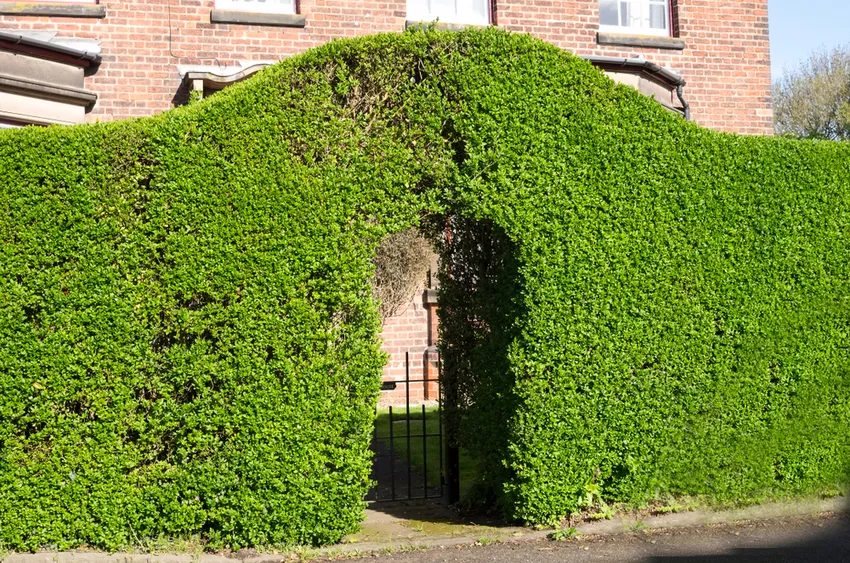- Advantages of a privet hedge
- Purchase of the privet plants
- A good location for a privet hedge
- The best time to plant a privet hedge
- Preparations for planting the hedge
- The ideal planting distance
- How to properly plant privet
- The first cut
- Keep the privet hedge in shape
- Watering and fertilizing the privet hedge
- create a mulch layer
Privet hedges are not very popular for nothing. The robust native shrub requires little care other than regular pruning, rarely gets sick or is infested with pests. What do you have to consider when creating a privet hedge and how do you plant and care for a privet hedge?
 Privet is a very popular hedge plant
Privet is a very popular hedge plant
Advantages of a privet hedge
Privet is very fast growing. With regular pruning, it forms many branches, so that the hedge quickly becomes opaque. Illnesses are very rare and are usually only caused by incorrect care. The privet can usually cope with pest infestation on its own.
The shrub is not evergreen, but the leaves of some varieties remain on the shrub well into winter, especially in bright locations, so that you have sufficient privacy even in winter.
The privet is also a good choice from an ecological point of view - in contrast to the cherry laurel - as the flowers and fruits provide a good food source for native insects and birds.
Purchase of the privet plants
There are many types of privet. Almost all are suitable for planting as a hedge. Only the non-hardy varieties such as Chinese privet are cultivated exclusively as bonsai or container plants.
Most varieties grow up to four meters high. If you are looking for a variety with long-lasting foliage, Privet atrovirens is the right choice.
A good location for a privet hedge
Privet likes it sunny and partially shaded. It does not tolerate direct shade very well.
The soil must be permeable to water, as the shrub cannot cope with waterlogging.
The best time to plant a privet hedge
In principle, you can plant a privet hedge at any time of the year - except when there is frost. However, the best time is autumn, as the soil has more moisture than in spring or summer. The young plants then do not have to be watered as much.
Preparations for planting the hedge
Dig a planting trench twice as wide as the root ball of the privet bushes.
Mix the substrate with mature compost and horn shavings (€32.93) so that you don't have to fertilize later.
If the soil is very dense, you should create a drainage system to prevent waterlogging.
The ideal planting distance
The planting distance depends on the size of the purchased plants. It also plays a role how quickly the hedge should be high and dense.
Plant smaller privet bushes at a distance of 30 cm, for larger ones the planting distance should be around 50 cm.
How to properly plant privet
- water the privet
- insert plant
- face earth
- dig a moat
- water well
Water the privet bushes for about 24 hours before planting. As a rule, you only have to cut open the bale wrapper. It will decompose on its own over time.
Plant the shrubs so that the root ball is just covered. Press the soil down well. Dig a small watering ditch around each plant, especially if you plant in a fairly dry period.
Water the hedge immediately, even if it is raining or rain is forecast.
The first cut
The first pruning takes place immediately after planting. This is carried out very strongly, the shoots are shortened by up to two thirds. This strong pruning is necessary so that the privet branches well and the hedge becomes dense more quickly.
If you omit this pruning, the hedge will remain leaky in the lower area.
Keep the privet hedge in shape
In the first few years you have to cut a privet hedge three times, namely in spring, August and early autumn. Later, a double cut is sufficient.
Cut the privet as conically as possible. With a square cut, the plant does not get enough light below and wilts.
If the privet hedge is already very bare at the bottom, you should cut the bushes to sticks in spring. This means that you shorten all shoots - top and side - by two-thirds.
Watering and fertilizing the privet hedge
Privet likes it neither dry nor too humid. Therefore, water very young plants frequently, but make sure that there is no waterlogging.
Fertilize the hedge in spring by giving it compost and horn shavings. Conifer fertilizer is also suitable as a long-term fertilizer.
Short-term fertilizer such as blue grain is given twice, each time about 14 days before the onset of new growth. Fertilization is done here at the end of April and the beginning of August.
create a mulch layer
The privet hedge gets it very well if you create a mulch layer under it. To do this, use leaves, lawn clippings, straw or chopped hedge trimmings.
The shrubs are supplied with nutrients by the mulch material and there is no risk of over-fertilising the hedge.
In addition, the mulch layer ensures that the soil does not dry out too much, so that the soil always remains slightly moist but not wet.
tips
You can easily propagate privet yourself from cuttings, sticks or sinking. To do this, simply use the cuttings left over from cutting back the privet hedge.